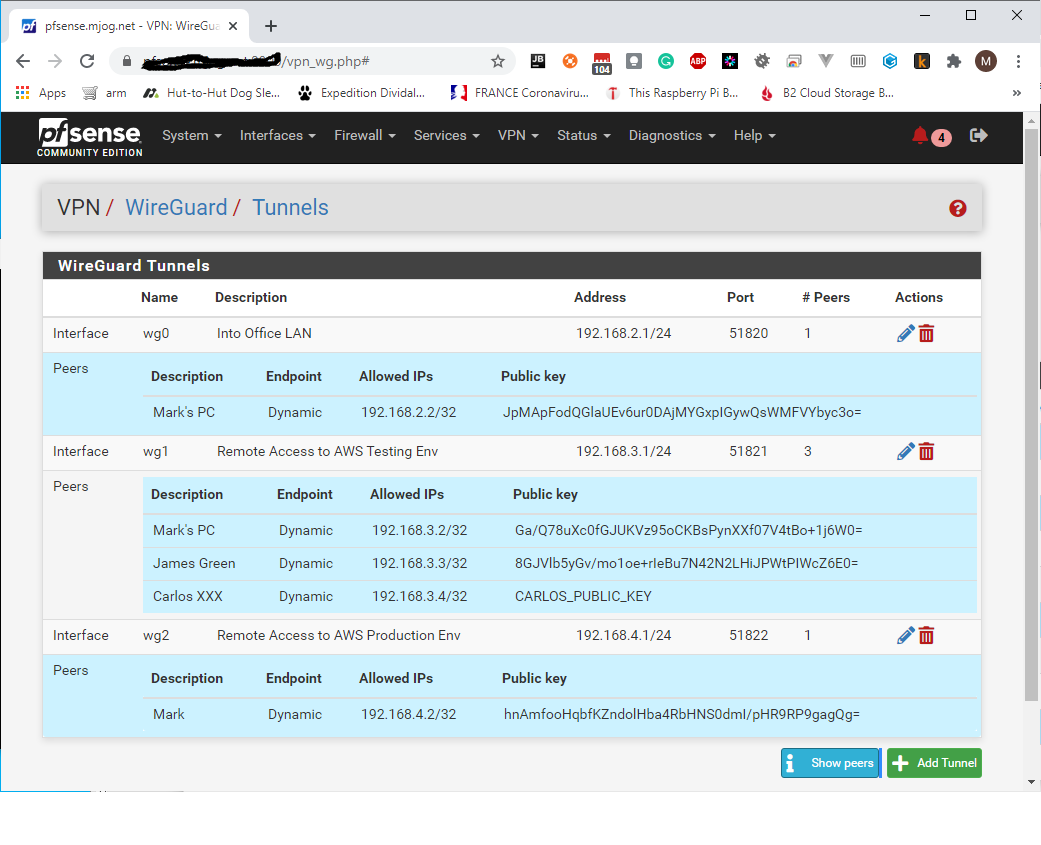WireGuard
Secure Tunnel with Cryptokey Routing & Roaming
Fast, Modern, Secure Tunel by Wireguard at pfsense+
Fast, Modern, Secure Tunel by Wireguard at pfsense+)
WireGuard® is an extremely simple yet fast and modern VPN that utilizes state-of-the-art cryptography. It aims to be faster, simpler, leaner, and more useful than IPsec, while avoiding the massive headache. It intends to be considerably more performant than OpenVPN. WireGuard is designed as a general purpose VPN for running on embedded interfaces and super computers alike, fit for many different circumstances. Initially released for the Linux kernel, it is now cross-platform (Windows, macOS, BSD, iOS, Android) and widely deployable. It is currently under heavy development, but already it might be regarded as the most secure, easiest to use, and simplest VPN solution in the industry.
WireGuard white paper
Conceptual Overview
if you'd like a general conceptual overview of what WireGuard is about, read onward here. You then may progress to installation and reading the quickstart instructions on how to use it. If you're interested in the internal inner workings, you might be interested in the brief summary of the protocol, or go more in depth by reading the technical whitepaper, which goes into more detail on the protocol, cryptography, and fundamentals. If you intend to implement WireGuard for a new platform, please read the cross-platform notes. WireGuard securely encapsulates IP packets over UDP. You add a WireGuard interface, configure it with your private key and your peers' public keys, and then you send packets across it. All issues of key distribution and pushed configurations are out of scope of WireGuard; these are issues much better left for other layers, lest we end up with the bloat of IKE or OpenVPN. In contrast, it more mimics the model of SSH and Mosh; both parties have each other's public keys, and then they're simply able to begin exchanging packets through the interface.
Simple & Easy-to-use
Cryptographically Sound
Minimal Attack Surface
High Performance
Well Defined & Thoroughly Considered
Simple Network Interface
WireGuard works by adding a network interface (or multiple), like eth0 or wlan0, called wg0 (or wg1, wg2, wg3, etc). This network interface can then be configured normally using ifconfig(8) or ip-address(8), with routes for it added and removed using route(8) or ip-route(8), and so on with all the ordinary networking utilities. The specific WireGuard aspects of the interface are configured using the wg(8) tool. This interface acts as a tunnel interface.
WireGuard associates tunnel IP addresses with public keys and remote endpoints. When the interface sends a packet to a peer, it does the following:
- This packet is meant for 192.168.30.8. Which peer is that? Let me look... Okay, it's for peer
ABCDEFGH. (Or if it's not for any configured peer, drop the packet.) - Encrypt entire IP packet using peer
ABCDEFGH's public key. - What is the remote endpoint of peer
ABCDEFGH? Let me look... Okay, the endpoint is UDP port 53133 on host 216.58.211.110. - Send encrypted bytes from step 2 over the Internet to 216.58.211.110:53133 using UDP.
When the interface receives a packet, this happens:
- I just got a packet from UDP port 7361 on host 98.139.183.24. Let's decrypt it!
- It decrypted and authenticated properly for peer
LMNOPQRS. Okay, let's remember that peerLMNOPQRS's most recent Internet endpoint is 98.139.183.24:7361 using UDP. - Once decrypted, the plain-text packet is from 192.168.43.89. Is peer
LMNOPQRSallowed to be sending us packets as 192.168.43.89? - If so, accept the packet on the interface. If not, drop it.
Behind the scenes there is much happening to provide proper privacy, authenticity, and perfect forward secrecy, using state-of-the-art cryptography.
Cryptokey Routing
At the heart of WireGuard is a concept called Cryptokey Routing, which works by associating public keys with a list of tunnel IP addresses that are allowed inside the tunnel. Each network interface has a private key and a list of peers. Each peer has a public key. Public keys are short and simple, and are used by peers to authenticate each other. They can be passed around for use in configuration files by any out-of-band method, similar to how one might send their SSH public key to a friend for access to a shell server.
Built-in Roaming
The client configuration contains an initial endpoint of its single peer (the server), so that it knows where to send encrypted data before it has received encrypted data. The server configuration doesn't have any initial endpoints of its peers (the clients). This is because the server discovers the endpoint of its peers by examining from where correctly authenticated data originates. If the server itself changes its own endpoint, and sends data to the clients, the clients will discover the new server endpoint and update the configuration just the same. Both client and server send encrypted data to the most recent IP endpoint for which they authentically decrypted data. Thus, there is full IP roaming on both ends.
Ready for Containers
WireGuard sends and receives encrypted packets using the network namespace in which the WireGuard interface was originally created. This means that you can create the WireGuard interface in your main network namespace, which has access to the Internet, and then move it into a network namespace belonging to a Docker container as that container's only interface. This ensures that the only possible way that container is able to access the network is through a secure encrypted WireGuard tunnel.
Tracking IP via WireGuard ...

